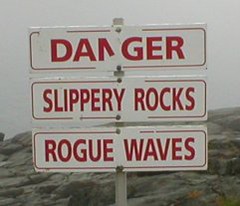Dactylology; and, where the hell are my keys???
Sign language class tonight. We're now considered "intermediate" level and, after getting used to things getting easier and easier, are on a big learning curve again :) .
At this point, we're still learning lots of new vocab, of course; but the emphasis is on a) improving our fingerspelling speed and b) syntax.
Native ASL users fingerspell at a phenomenal pace. Commonly-spelled words - names, for example - are spelled so quickly that they appear to be one sign - a flick of the fingers. "Charles" is patiently helping us speed up both our own fingerspelling and our comprehension of fingerspelled words. Tonight was a typical exercise - we worked on a list of long and relatively complicated words (exercise, immediately, mortgage, dactylology*, calendar). Most of these words have handsigns to express them, but the exercise was in fingerspelling. We practiced them with each other, and then Charles went around the room and fingerspelled them to us, one at a time - first, at a native signers' speed; then, if we didn't get it, more slowly, then more slowly, and so on. When we 'got' the word, we spelled it back. We did pretty darned well - most of us got most of them on the first or second spelling.
The syntax we are learning is key, basic ASL syntax - areas where ASL differs from English syntax, and areas basic enough to everyday conversation that an English signer would need to know the difference. For example, when describing the location of an object, in English you would say:
"The keys are on the second shelf of the bookcase."
In ASL you would sign (roughly):
Bookcase; shelves; second shelf; there; keys.
Or possibly:
Bookcase; shelves; second shelf; there; keys; that shelf; keys. (You basically sign the concept as you need to until the reader 'gets' where the keys are.)
This is very cool and interesting and useful stuff, and while we have indeed hit another steep grade on the learning scale, we can connect what we are learning to practical use, which makes it feel worth the rough sledding.
*dactylology - the study of signing and fingerspelling.
ronnie



2 Comments:
Interesting!
This ASL syntax "Bookcase; shelves; second shelf; there; keys...." aligns with a great way I've learned to tell a young person where to find something.
I start broad and move to the specific when I send my 6-year-old on a mission.
"Go to the basement, open the tool box, lift out the second layer, bring the hammer upstairs to me. Please."
This works FAR better than "Please bring me the hammer." This leaves a lot open to interpretation, and questions to ask. (And boy, does he have questions!)
There's also much less chance he'll get distracted by something down there, or come back with a wrench, or use the hammer somewhere enroute.
It's a very efficient way of directing.
And it's probably why Dora the Explorer rivets him to the spot.
Shoes. Coat. On. NOW!
Excellent observation, Yvonne. I think that ASL breaks away from English at such fundamental points. It's been designed to be a very... functional type of communication, whereas verbal language is a very... complex type of communication.
I think a lot of ASL has its roots in those early-years, connect-the-dots, brain-syntax kind of understanding. Verbal communicators then continue to complicate and finesse things - while ASL sticks to our early brain-mapping.
Maybe. :) Well, it's a theory.
ronnie
Post a Comment
Subscribe to Post Comments [Atom]
<< Home